In recent years aerial photography using drones has expanded exponentially. Photographers are no longer limited to mainly three-quarters view of trains from the sides of lines or bridges or adjacent hills. Now, the opportunities are endless for photographing trains and railway establishments.
Published in November 2023 by Amberley Publishing and written by Rob Higgins, this soft cover landscape format book measures around 16.8 cm x 24.6 cm, and has 128 pages and 125 illustrations. It has a published price of £17.99, but at the time of writing, it can be purchased for £16.19 from Amberley Publishing and for £13.35 from Amazon.
This book takes the reader on an aerial view of Britain’s railways travelling anti-clockwise around the country from the Midlands along the West Coast to Scotland then down via the East Coast to the Norfolk Broads with a few images in Southeast and Southwest England and South Wales.
Along the way, there are previously unseen views of industrial installations, marshalling yards, and a large number of viaducts and bridges.
The use of drone photography provides an opportunity to gain an impression of an overall site, far easier than viewing it from the ground. This is seen in the photos of Crewe below, with on the left Gresty Bridge depot and the right Crewe Vehicle Maintenance Depot, a far cry from Crewe North and South engine sheds in the days of steam.
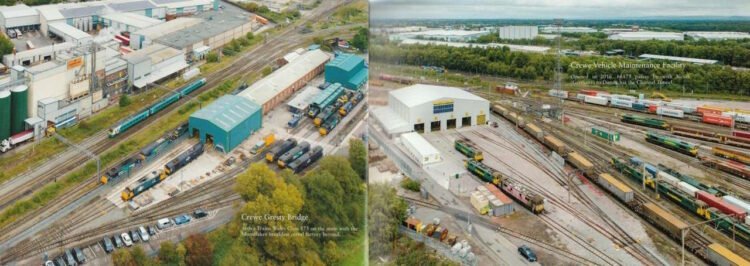
These photos also exemplify what will be seen in another example how the captions often get lost in the photograph. Although the caption to the left-hand photo says Confluence of Tame and Trent, there is no indication as to which river is which, or where this is located.
The photo on the right shows Stud Farm, but other than rail enthusiasts few people will know where this is situated.
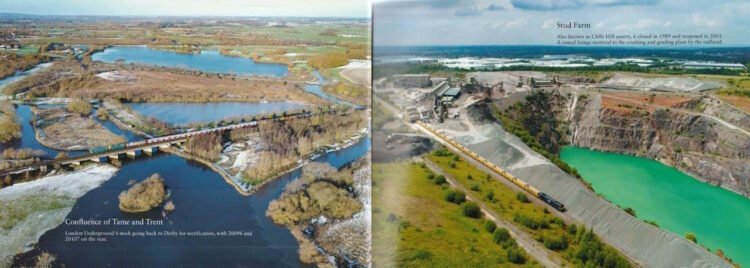
Until a few years ago, photos such as the ones below could only have been obtained while flying in an aircraft or helicopter. Now they are obtainable by anyone who has a drone equipped with a camera.
Once again, these are let down by poor placement of the captions. This is a recurring theme, with no consistency in their placement. It would have been far better if they were positioned in the same locations on the page and at the same alignment from the top edge. The caption to the left-hand photo says that the train is about to enter Blea Moor Tunnel, although there is no sign of the tunnel in the photo.
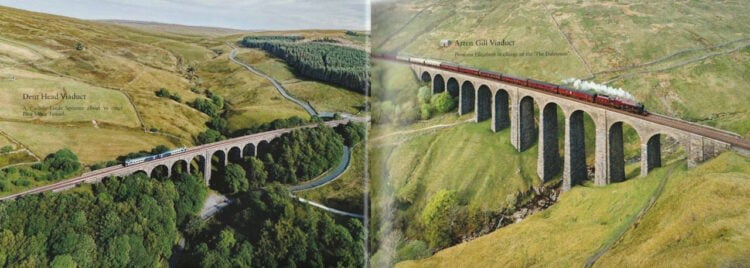
In many of the book’s captions, the author seems to be aiming at a target audience of railway enthusiasts with the use of colloquial terms rather than more expansive descriptions.
The left-hand photo is an example, with the caption stating “with the Fort William-North Blyth Alcan empties”. In contrast, it would have been more useful to have stated something along the lines of “with empty wagons to North Blyth from the Alcan aluminium smelter at Fort William”.
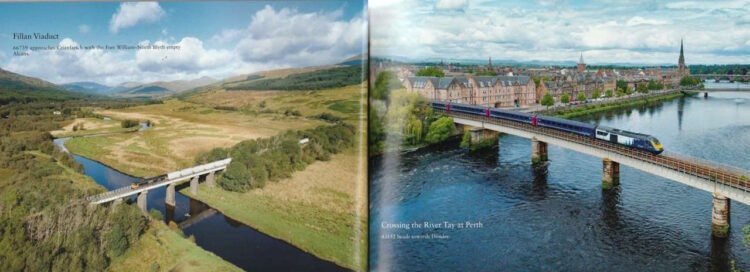
The left-hand photo below highlights what can be achieved with drone photography, by showing the complete length of the Welland viaduct, which so often in normal photography is much truncated. Again, these photos have been let down by the positioning of captions, and in these photos black text in one and white in the other. It would have been more satisfying to have both captions at the top, with the left caption on the left side of the page and the right caption at the top right.
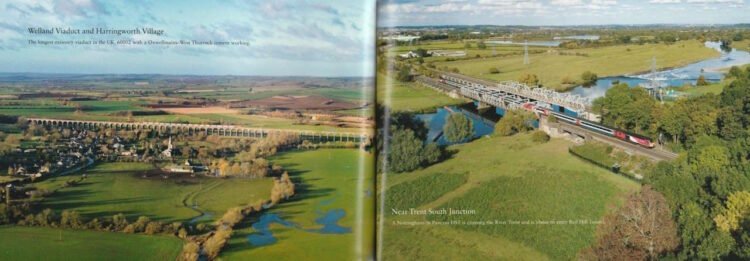
All photographs in this book stand out for their excellent reproduction with superb depth of field to maintain definition throughout. Each photograph fills the page with no surrounding white space, but this has caused a problem with great inconsistencies in caption positioning.
Caption positions vary from page to page, with some at the top, others at the bottom, and some seeming to have been dropped haphazardly on the page. Some are also in black, others in white, and the background seems to have no influence in either text colour or caption position.
Although drone photography is in its infancy, the author has mastered the art with a book full of well composed images of railways in both rural and industrial settings.
Many of the locations may be familiar to purchasers of the book, but the aerial views capture scenes that show many features that will be totally unfamiliar. Despite the criticism about the captions, the book shows what lies ahead for anyone contemplating expanding their photography skills.
The book is available to purchase from Amazon and Amberley Publishing.
We would like to thank Amberley Publishing for providing us with a copy of the book for review.





Responses